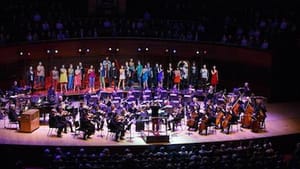Stay in the Loop
BSR publishes on a weekly schedule, with an email newsletter every Wednesday and Thursday morning. There’s no paywall, and subscribing is always free.
Sharks vs. Jets vs. Orchestra
Philadelphia Orchestra presents ‘West Side Story' in Concert

As Leonard Bernstein’s centenary approaches, music lovers must prepare for deep dives into his catalog from their local orchestras. Philadelphia Orchestra’s Lenny-heavy season begins ambitiously with a semi-staged concert of West Side Story, conducted by music director Yannick Nézet-Séguin. Metropolitan Opera mezzo-soprano Isabel Leonard anchors the cast as Maria, under the direction of Kevin Newbury.
A musical triumph
The 1957 musical may seem an odd choice for an orchestral concert, but Nézet-Séguin’s fine reading of the score stressed Bernstein’s myriad classical analogs. The violin tremolos that introduce “Tonight” took on an almost Straussian shimmer — ideal for falling overwhelmingly in love. The galloping pace of “I Feel Pretty” served as a reminder that the number is, in fact, a waltz. Nézet-Séguin drew out the atonal underpinnings of “Cool,” which made it feel even more menacing than usual.
Elsewhere, the orchestra showed a surprising ease in communicating the work’s jazz, pop, and mambo influences. Much credit belongs to percussionist Angela Zator Nelson, who layered hot rhythms on the xylophone and bongos that added authentic flavor to the strings, brass, and woodwinds. “The Dance at the Gym” unspooled as a conversation between old and new music, mirroring the tension between the second-generation-Italian Jets and the newly arrived Puerto Rican Sharks.
A dramatic misfire
In their zeal to foreground the complexities of Bernstein’s musical writing, though, Nézet-Séguin and Newbury frequently subjugated the drama. This was literally represented by the decision to place the singers behind the orchestra for the duration of the performance. Although they stood on a slightly raked platform, a good deal of the action remained obscured by music stands and quivering bows. Two television screens, mounted in the onstage boxes, offered close-ups of key moments, but this only further emphasized the distance between performers and audience.
The concert adaptation cut nearly all of Arthur Laurents’s extraordinary libretto, which still feels sharply ahead of its time in its use of vernacular speech and off-color language. Some songs — such as the panto-tinged “Gee, Officer Krupke” — appear out of nowhere, losing their bite from the lack of context. Other moments, including the attempted rape of Anita by the Jets, should have probably been cut. My heart sank when I realized Maria’s final speech, a highlight of any production, wasn’t coming. Its absence caused the piece to end without much catharsis.
Inconsistent casting
It’s a shame, because Leonard showed herself a capable actor. Although slightly too mature in certain moments, she infused Maria with an appropriately dramatic wryness. Leonard’s interpretive instincts in the few remaining book scenes made up for a somewhat bland musical performance that often found her cleaving to the letter of the score.
Other performers fared less well, on both counts. As Tony, the slicked-back, leather-jacketed Ryan Silverman looked like a Midwestern community theater’s idea of a street tough. His acting suggested neither pure love for Maria nor the swirl of violent rage that causes him to kill her brother, Bernardo (the excellent, underutilized bass-baritone Nathaniel Stampley). His pinched, nasal tenor moved roughly through the passaggio, turning “Something’s Coming” and “Maria” into unpleasant endurance tests.
Isabel Santiago had voice to spare as Anita, but she frequently pumped out her sound like a French taxi horn, with scarcely any chromatic variation. Worse still, she made a poor habit of playing directly to the audience — as did Timothy McDevitt, a generic and unthreatening Riff. The ensemble, composed primarily of musical-theater performers, largely remained indistinguishable, with the exception of Nora Schell’s vividly sung Rosalia.
The real star
As is often the case when he’s on the podium, the concert’s most engaging performer was Nézet-Séguin. His animated conducting style, which can feel out of place in Verdi or Wagner, complemented the high-octane action here. He bopped and weaved with the music and frequently mouthed the words; occasionally, his baton technique resembled air guitar. I have a sneaking suspicion the folks in the conductor’s circle probably got a better show than those of us seated in the orchestra.
Editor's note: The orchestra has paired with Taller Puertoriqueño to fundraise for Puerto Rico hurricane relief. Those attending performances can donate cash or by check (made out to “Concilio/UNIDOS PA’PR”) in the lobby of the Kimmel Center before and after performances, as well as during intermission. You may also donate online at www.elconcilio.net/donate, by text message (text “Donate” to 1-833-215-7277), or send checks payable to “Concilio/UNIDOS PA’PR” to 141 East Hunting Park Ave, Philadelphia, PA 19124. Contributions will be donated through various reputable organizations, including the Salvation Army and American Red Cross, to aid their ongoing efforts in various areas to help those in crisis in Puerto Rico and the surrounding area. More information on how to donate is available on Taller Puertorriqueño’s website at http://tallerpr.org/2017/09/26/unidos-papr-hurricane-relief-efforts/.
What, When, Where
West Side Story in Concert. By Leonard Bernstein, Arthur Laurents, and Stephen Sondheim. Kevin Newbury directed, Yannick Nézet-Séguin conducted. The Philadelphia Orchestra. Through October 15, 2017, at the Kimmel Center’s Verizon Hall, 300 S. Broad Street, Philadelphia. (215) 893-1999 or philorch.org.
Sign up for our newsletter
All of the week's new articles, all in one place. Sign up for the free weekly BSR newsletters, and don't miss a conversation.

 Cameron Kelsall
Cameron Kelsall